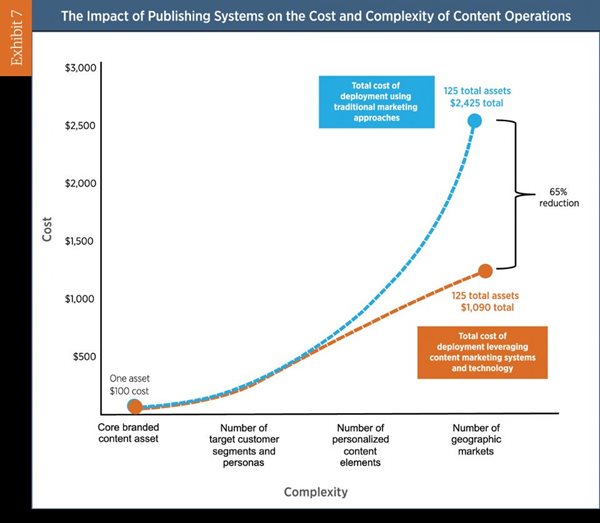Have You Been On The Wrong Path to Pick the Right WCM?
What is holding enterprises back when it comes to successful WCM implementation? During  the process of selecting the right CMS, it is so common to get paralyzed. What I mean by that is frustrated by not making any progress and yet, not confident enough to move forward.
the process of selecting the right CMS, it is so common to get paralyzed. What I mean by that is frustrated by not making any progress and yet, not confident enough to move forward.
Not to waste your time by watching demos without even knowing what you are looking for, you have to underline and document what the business is trying to accomplish with a content management system. That statement should be powerful enough to be your North Star reference point. As there are so many moving parts along the path, if you feel like you're losing sight of the project, that reference point can help you get back on the track.
Document Your User Groups with Their Use Cases
After deciding on the primary purpose of the project, you will need to collect priorities of every department involved in the CMS selection process. However, this is where many organizations get paralyzed because when they assemble the requirements collected across the organization, the end-picture often over-complicates the process due to some clashing requirements between the different departments. Therefore, most of the time, asking stakeholders to list a bunch of requirements doesn’t take the project too far. Then, how can you thoroughly understand your stakeholders’ needs without getting paralyzed by the end result? The short answer is finding out business use cases rather than naming features. Let me expand on that idea.
First things first, who are those stakeholders? I won’t start listing department names like Sales,  Marketing, IT, and such as every organization has a different structure so inclusion and exclusion criteria may vary. At the end of the day, the point of this stage is understanding the functionality you will need to look for while making your shortlist of content management software so why not categorize your stakeholders based on their functionality within the organization? With that logic, you will have content publishers, content consumers, administrators, and developers.
Marketing, IT, and such as every organization has a different structure so inclusion and exclusion criteria may vary. At the end of the day, the point of this stage is understanding the functionality you will need to look for while making your shortlist of content management software so why not categorize your stakeholders based on their functionality within the organization? With that logic, you will have content publishers, content consumers, administrators, and developers.
To put your user groups and their use cases together will automatically begin to tell you a story. As an example, let’s take a closer look at the most common business use cases for content publishers. This specific user group is mostly tasked with:
-
Creating and updating content such as text, video, image, links, sidebar, alt tags, metadata, and so on
-
Reviewing and editing the content based on not only grammar but also file naming conventions, controlled vocabularies, brand messaging guidelines, editorial style and tone guidelines, editorial calendars, and SEO keywords/content pillars
-
Collaborating on the content for revision
-
Creating permission levels based on the roles and responsibilities of each player involved in the content publishing process
-
Testing the content across all the concerned platforms
-
Scheduling the content for publication
-
Publishing live content
-
Promoting the content across channels
Now, this list is obviously a baseline as it may expand based on the roles and responsibilities involved. And, this type of list should be formed for content consumers (external and internal) who are reading, searching, commenting, sharing, etc; administrators who are tasked with things like system updates, upgrades, and maintenance; and developers who are concerned with tasks like web components such as menus, header/footer; templates for the structured content; and integration with other web services which tends to be where most of the challenges lie.
How to Utilize Those Use Cases While Choosing Your CMS
You have categorized your user groups and documented their use cases for a content management system. Now what? Yes, it’s very strenuous trying to assume all scenarios and document them, but this helps not only with the evaluation process of content management software but also with the auditing process of existing processes and ultimately with alleviating pain points. So many birds with one stone!
First, this documentation will help with your evaluation process big time as you will be able to quickly filter down the list of CMS software options based on how well they address those use cases. It is very easy to be convinced by vendors as their sales representatives are trained to do so after all. This preparation is also helpful for the communication with the vendors you are considering as you are letting them know the areas of your focus and allowing them to explain how they can address them with their products and services. This makes the process more efficient and effective for all the parties.
Secondly, parallel to the same logic, you can include those documented use cases by user groups in your RFPs as it gives them a clearer direction as you cannot get more specific than this. Having practical background stories rather than theoretical requirements in a bullet-point form would not only reduce the risk of miscommunication but also bring the project up to speed.
Thirdly, one of the good things about replatforming is that it gives you an excuse to audit your workflow and see the current business process in a different angle. Now that each stakeholder’s workflow is laid out, you might as well put that to work for forming a more collaborative environment or updating your digital strategy and roadmap. Depending on the methods where your team operates the best, you may even play out in a visual sense and create some sort of vision board of your workflow by placing post-its. That way you may detect a disconnect between departments or some tasks that may create silos within the organization.
How to Rule out Platforms to Narrow down Your Focus
With the advent of technology, all the major WCM vendors are capable of addressing even very intricate and complicated needs for a content management system. Therefore, choosing the right CMS depends on not only your business requirements but also your digital ecosystem. If you have already made significant investments in a specific architecture or hosting environment, there is no point in wasting your time with the options that cannot support your existing technology investments as shifting away from your infrastructure for a CMS is troublesome on so many levels. With this in mind, you need to filter the list of your options based on technologies that your digital infrastructure is able to support. On that note, there are still many technologies with a great customer value but have a limited ecosystem to support larger deployments.
intricate and complicated needs for a content management system. Therefore, choosing the right CMS depends on not only your business requirements but also your digital ecosystem. If you have already made significant investments in a specific architecture or hosting environment, there is no point in wasting your time with the options that cannot support your existing technology investments as shifting away from your infrastructure for a CMS is troublesome on so many levels. With this in mind, you need to filter the list of your options based on technologies that your digital infrastructure is able to support. On that note, there are still many technologies with a great customer value but have a limited ecosystem to support larger deployments.
Another factor to narrow down your list is obviously your budget. Embracing a content management system is not a set-it-and-forget-it process. Besides the upfront fee, you need to take into consideration the hidden costs. You should definitely rule out the platforms that will cost far more than your budget but also be careful with the other that just meet your threshold.
When you are allocating your budget, it is also important to keep in mind that implementing a WCM solution is not an inexpensive undertaking. However, the opportunity cost can easily add up to be more than your total cost of having the right technology in place. Also, there is a misconception on the cost of web content management technology implementation. To back up my point, I would like to share the chart by Forbes below that illustrates the impact of the publishing system on the cost and complexity of content operations:

During the interview with Mark Grannan, he told us the WCM implementation decision should be made based on the organization's priority. However, coming to an agreement on the priority level can be harder than it sounds: “It is amazing how political and emotional those conversations about who gets funding and budget and when can get between various groups.” He recommends taking an outside-in approach as it does not only help organizations in making priority judgment calls but also takes a lot of emotion out of the internal discussions.
Some WCM vendors provide a great customer value, however, they might have the limited geographic scope. It is wise to eliminate platforms that you probably cannot get adequate support for within your region. Working on this kind of project with the overseas team might result in miscommunication, delays, frustration, and ultimately failure.
First, Do Your Secondary Research
If you want every dollar invested on your technology landscape to add value for the consumer  or add value for your stakeholders, some due diligence is definitely needed and can save your business from trouble and financial loss. You should do your market research to understand what your options are within the market where everything is moving at a very fast pace. During your due-diligence, there is also one paramount consideration factor that you should always keep in mind: what can change in the next couple of years as your business ramps up? That mindset will lead you to pick a future-proof platform in the end. At the end of the day, buyers should aim for finding the best match rather than simply the best product in order to maximize their every digital investment dollar’s effectiveness.
or add value for your stakeholders, some due diligence is definitely needed and can save your business from trouble and financial loss. You should do your market research to understand what your options are within the market where everything is moving at a very fast pace. During your due-diligence, there is also one paramount consideration factor that you should always keep in mind: what can change in the next couple of years as your business ramps up? That mindset will lead you to pick a future-proof platform in the end. At the end of the day, buyers should aim for finding the best match rather than simply the best product in order to maximize their every digital investment dollar’s effectiveness.
CMS is where all pulling, sterilizing, delivering, tracking, and optimizing of content is happening so if “content is king”, then, content management platforms are the gravitational center of digital experiences. In this stage of your purchasing journey, you can tap into informative, third party and vendor-neutral content such as eBooks, white papers, analyst reports, research reports, expert content, blogs, case studies, and newsletters.
When you have your top-three vendors in your short-list, in-depth comparison reviews are also very beneficial as their features, track-records, strategic roadmaps, ecosystems and market presences are all outlined and compared to each other. As an example of the concept, CMS-Connected’s Principle Analyst Gary Eisenstein has covered the most popular .NET CMS solutions, seen here: A Fair Review of the Top .NET CMS Platforms. Not only analysts but also user-generated comparison reviews are very beneficial to look under the hood as well.
Then, Do Your Primary Research
You do not need to reinvent the wheel to understand whether a platform could cater to your needs.  Online resources mentioned above are always a great start to explore, however, do not limit yourself to only them. With so many variables to consider and every organization having its own unique needs and goals to meet, to connect with an organization that has struggled with the similar business issues to yours can go a long way. Learning what has set them up for success or failure within the content management implementation process eliminates so many potential troubles before having to experience them first hand.
Online resources mentioned above are always a great start to explore, however, do not limit yourself to only them. With so many variables to consider and every organization having its own unique needs and goals to meet, to connect with an organization that has struggled with the similar business issues to yours can go a long way. Learning what has set them up for success or failure within the content management implementation process eliminates so many potential troubles before having to experience them first hand.
To make that type of connection with your counterparts, social media is a great platform. People are constantly sharing their opinions via Facebook and LinkedIn groups. If you start a thread, there won’t be a shortage of opinions. If you don’t want to open it to the floor, you can always have those conversations in a personal setting to learn the greatest barriers others have faced while implementing the WCM platforms that made it to your shortlist. It is hard to overestimate the benefits of learning from others’ mistakes in the decision-making process, so you get the idea behind running primary research.
Ending Notes
Selecting a content management system may not be rocket science but it is not a decision to be taken lightly either as implementing and customizing a content management system involves big bucks and a lot of effort across cross-functional departments. Unfortunately, there is not a magic button that you can use to switch over your platform when things are going down hill. This situation alone makes your choice all the more important. So as you see, putting in a great deal of work before your call will save you more time, resources, and money than you probably assume in the end.
It is important to always remember that no matter how robust a technology is, it is inanimate and we, as human beings, are supposed to breathe life into it. If you do not know your direction, you will be lost regardless of what make your car is. That being said, you may not feel confident about reviewing all the platforms available to find the best one to suit your business requirements, and that’s certainly okay. None of us operate like a Swiss Army knife after all. Therefore, after outlining your needs, goals, business use cases, and doing your research, you may want to discuss all your findings with the experts so they could plug the holes left out in your playbook.
Happy CMS picking!

Venus Tamturk
Venus is the Media Reporter for CMS-Connected, with one of her tasks to write thorough articles by creating the most up-to-date and engaging content using B2B digital marketing. She enjoys increasing brand equity and conversion through the strategic use of social media channels and integrated media marketing plans.